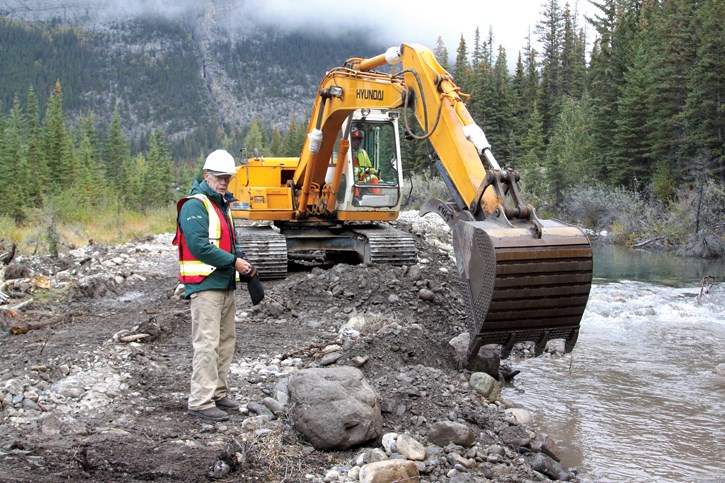BANFF – A vision to restore and return native fish to Cascade Creek – a highly controlled and regulated creek below Lake Minnewanka dam – is a step closer to reality.
With the use of heavy machinery to move rocks and debris that came down in the 2013 flood, a narrower, four metre-wide step channel with pools, runs and rock riffles is currently being built along a 250-metre stretch between Cascade Ponds and the Trans-Canada Highway to create new habitat for fish, insects and aquatic vegetation.
This pilot project is part of an ambitious plan to see the creek run along its historic 13.5 kilometre alignment from Lake Minnewanka to its confluence with the Bow River and to bring back native fish, potentially threatened westslope cutthroat trout, which occupy only five per cent of their original habitat in Canada.
Robert Newbury, a world leader in stream restoration, is working with Parks Canada on this pilot project.
“The benefits will be to have a reconnected stream with a native fish population that should have been here, not some invader from elsewhere,” said Newbury, a stream hydrologist and president of Newbury Hydraulics.
In preparation for the creek’s restoration, approximately 22,000 non-native brook trout have been removed over several years. Block nets are currently in place in the lower reaches of the creek to stop non-native fish from heading upstream.
Creating a healthy aquatic ecosystem includes suitable fish breeding and rearing habitat with appropriate water depths, flows and in-stream and riparian cover to support a self-sustaining native fish population.
Bill Hunt, resource conservation manager for Banff National Park, said whether minnows and suckers or westslope cutthroat trout or bull trout are put in Cascade Creek would depend on the habitat quality created in the restoration.
“It will depend on what we’re seeing for temperatures, overwinter flows, and viability of the pools over wintertime,” he said.
“We don’t want to put fish into a situation where pools are drying up and they’re dying.”
At the same time, Hunt pointed to the fact that non-native brook trout lived in the creek for years and years.
“There are different habitat requirements for sure, but we’re confident by the end of this we’ll have viable trout habitat,” he said.
The current Minnewanka dam was built in 1941, forming the Lake Minnewanka reservoir, which diverted Cascade River through the Two Jack Canal system to the TransAlta Cascade hydro power plant.
Its historic flows were about 15 per cent of the volume of the Bow River, but construction of the dam reduced the river’s flows by more than 99 per cent – not enough to support a healthy aquatic ecosystem.
Now referred to as Cascade Creek, it functions as the reservoirs’ spillway for emergency flood situations, with only a small flow rate maintained by way of a pipe through the dam.
The creek hadn’t made its way to the Bow River for decades, but, during the 2013 flood when TransAlta opened its emergency spillway, the creek returned to its historic path, including along the grassy ditch by Legacy Trail.
With base flows improved, coupled with remediation work on other sections of the creek, including Cascade Ponds and Cascade Pits, the creek flowed to TransAlta’s manmade channel carrying water from the power plant to the Bow River at certain times this summer, although it isn’t right now.
Typically, Cascade Creek flows about 150 metres below the railway line and then disappears at the site of an old pit. More work is on the books for next year to continue its flow to TransAlta’s manmade channel.
Hunt said the new channel below Cascade Ponds is being designed in such a way to allow for fish passage under a range of low stream flows to accommodate flood conditions.
“What we’ve realized is we can build good, solid reliable fisheries habitat through here by maintaining year-round flow, maintaining that connectivity, and making sure there’s enough deep pool habitat for fish to overwinter,” he said.
“We need enough flow for connectivity, so that’s sort of our bottom line. If we can have overwintering pools and connectivity, we don’t need 100 per cent of what the river was in order to restore it, not even close.”
Hunt said aquatic ecosystems are in peril across North America, noting native fish populations are petering out in many places.
“There’s a lot of studies now that fish assemblages are affecting others in the food web – birds, waterfowl, insect-eating birds,” he said.
“We know from our monitoring that the aquatic ecosystem is the most degraded ecosystem in Banff Park. Restoring this creek is going to restore integrity.”
Newbury said the riffles that are being built – like a small rapid – also play a secondary role in stream restoration, acting as feeding stations. In fact, the term ‘Newbury weir’ or ‘Newbury riffle’ was coined for his design.
“The fish are going to be in here and they’re going to be feeding on insects. Insects go where the riffles are because that’s the only place where there’s enough sunlight to grow algae for the insects to live on,” he said. “So we’re creating these feeding stations.”
The plan is to do similar remediation work in 2019 at different locations along Cascade Creek, primarily south of the Trans-Canada Highway to TransAlta’s manmade channel. In total, the work covers about six kilometres.
Helen Dickinson, project manager and a resource management officer in Banff National Park, said the plan is to look at the success of this section and apply the restoration template to other sections of the creek.
“Every reach is different and needs a slightly different treatment,” she said.




